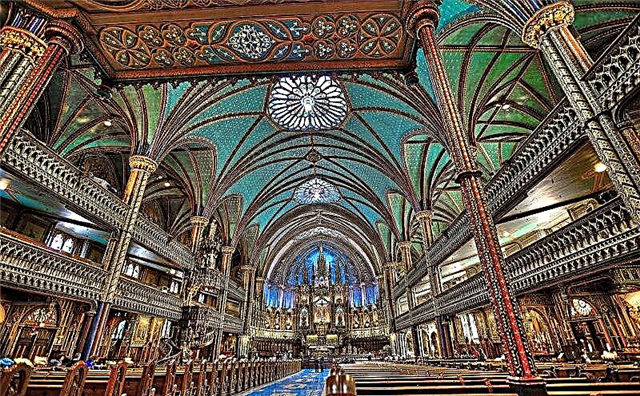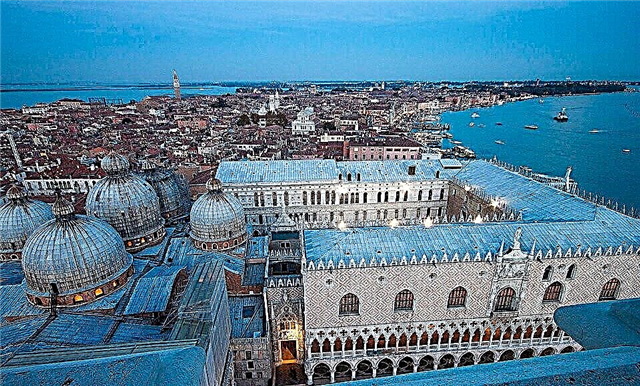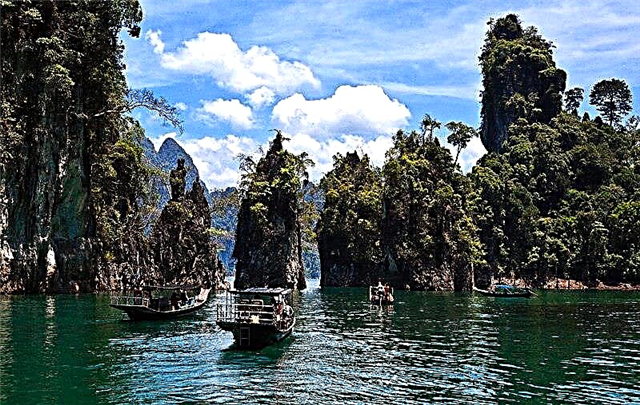Address: Russia, Moscow, Moscow Kremlin
Start of construction: 1960 year
Completion of construction: 1961 year
Capacity: large hall for up to 6000 people
Coordinates: 55 ° 45'05.1 "N 37 ° 36'55.9" E
Content:
Until 1992, the newest of the palace buildings in the Moscow Kremlin was called the Palace of Congresses. For several decades it was used to hold party and trade union forums and other national events. Today, the imposing palace serves as a venue for theatrical performances and concerts. Anyone can inspect it from the outside, and only spectator tickets are allowed inside the building.

Palace from the side of Ivanovskaya square
Construction history
Until the 60s of the last century, party congresses were held in the Column Hall of the House of Unions and in the Grand Kremlin Palace. However, over time, the scale of these responsible meetings increased, and the country's leaders came to the conclusion that a more modern platform was needed to hold them. The initiator of the construction of the new building was the party leader of the Soviet state - N.S. Khrushchev.
When the decision was made, they thought about the question - where to build a new palace? The designers proposed several possible sites - the territory of the Exhibition of Achievements of the National Economy, a place on Vorobyovy Gory near the university and the embankment, where the Cathedral of Christ the Savior now stands. They even wanted to demolish the famous Gostiny Dvor under the palace. But in the end, the choice fell on the Moscow Kremlin. This place was perceived as the heart of the capital and a symbol of statehood, therefore the Kremlin territory was most suitable for a monumental building.
Then a closed competition was held for the architectural designs of the new palace. And among 12 applicants, Mikhail Vasilyevich Posokhin won, who became the leader of a large-scale construction project. In addition to him, several more architects and engineers were included in the team of authors, and all of them were awarded the Lenin Prize upon completion of construction.

Palace from the side of the Trinity Tower
To prepare a large site, six buildings of the 15th-19th centuries were demolished in the Kremlin. These were the so-called "pre-fire" buildings, that is, they were erected before the great fire of 1812. Among other houses, the old mansion, which was formerly occupied by the Armory, was liquidated. The three-storey building in the Empire style was built at the beginning of the 19th century under the leadership of the famous Russian architect Ivan Vasilyevich Yegotov. Old cannons stood along it, and they were moved to the Kremlin Arsenal. And the Tsar Cannon, the largest in size, was installed on the spacious Ivanovskaya Square.
The construction of the new palace took place in record time. It was built in just 16 months and opened in 1961. It is interesting that during this short time the project was radically altered several times, adjusting to new needs.
Initially, it was proposed to build a conference hall with a capacity of 4,000 seats. However, N.S. Khrushchev, impressed by the new Palace of Congresses in Beijing for 10 thousand spectators, ordered to increase the hall in the new Kremlin palace. His request was granted, and the meeting room was expanded to 6,000 seats. In addition, a large banquet hall was erected, designed for 2.5 thousand seats or 4.5 thousand guests during receptions. Because of this, the inner space of the new building has grown so much that part of the floors had to be removed underground.

Southeast facade of the palace
The grand opening of the palace took place in the fall of 1961. At a banquet on the occasion of this event, the new building was called "the brainchild of the thaw." The guests invited to the opening were able to see a concert program with an excerpt from the ballet by P.I. Tchaikovsky "Swan Lake" and performances by artists of different genres.
Features of architecture and interior decoration
The Congress Palace is one of the few Kremlin buildings that are not included in the UNESCO World Heritage List. It measures 120 by 70 m, consists of six floors and therefore obscures the golden domes of the Assumption Cathedral from the view of those entering the Kremlin.
The underground part of the palace is deepened by 14 m, which corresponds to the height of a 5-storey building. The State Kremlin Palace and the Grand Kremlin Palace, which houses the office of the President of Russia, are interconnected by a system of ground crossings.
Outside, the building is faced with marble brought from the Urals, beautiful anodized aluminum and glass panels. Previously, the gilded coat of arms of the USSR was located above its entrance, and now the coat of arms of Russia is fixed in this place.

Facade of the palace
The huge palace consists of 800 rooms and corridors of various sizes, and has 23 elevators and one large lift that can accommodate an entire car. The spacious stage measuring 40 by 23 meters can simultaneously accommodate up to 1000 artists. In 2013, the stage premises were completely modernized, and now they meet the most modern requirements.
The interior decoration of the Palace of Congresses is made of red Karbakhtin granite, patterned tuff from Baku and snow-white Koelga marble. In addition, ash, oak, hornbeam, Pacific walnut and beech panels are used in the decoration of rooms and halls. Due to such a varied decoration, the interior of the palace looks restrained and solemn.
The stage curtain is made of thin sheets of metal minted by the masters of the Art Fund of Latvia. And the coat of arms in the main foyer is made of colored smalt according to the drawings of the famous Soviet artist Alexander Alexandrovich Deineka.

What can be seen in the palace
Nowadays, performances of the "Kremlin Ballet" theater are shown on the stage of the palace. This theatrical collective was founded in 1990, and the leading soloists of the Bolshoi Theater of the country danced in its first performances.
Today, musicians of the most famous orchestras of Russia take part in the performances of the theater. The Palace of Congresses shows the classical ballets Macbeth, Ruslan and Lyudmila, The Nutcracker, La Bayadere, Swan Lake, The Magic Flute, Don Quixote, The Sleeping Beauty and Giselle.
In addition, festivals of ballet, children's and student creativity, charitable programs and creative evenings are held here. Eminent orchestras, choirs, chamber music groups, popular actors and famous soloists perform on the stage. Jazz and rock are played here, author's and folk songs, popular music and romances are played, as well as choreographic ensembles demonstrate their skills.
Every year, the main New Year tree in Russia is organized at the State Kremlin Palace. In Soviet times, tickets for it were almost impossible to get, so they were distributed among the children of the nomenklatura and among the excellent students of Moscow schools. The performances from the Christmas tree were broadcast on television, and gifts for the participants were packed in beautiful plastic boxes made in the form of the Kremlin's Spasskaya Tower.

Arsenal Reflection
Useful information for visitors
The ticket offices of the State Kremlin Palace are located near the Kremlin, on the street. Vozdvizhenka, 1. They work every day, seven days a week, from 12.00 to 20.00.
You can get to the Kremlin only through checkpoints. Passage with tickets to the Palace of Congresses begins 1 hour 45 minutes before the start of the concert or performance. They are not allowed into the building with backpacks, briefcases, parcels and bulky luggage. If there is such luggage, it must be left in a paid storage room, which is located on the territory of the Alexander Garden.
It should be borne in mind that during events inside the palace, it is not allowed to use mobile phones, camcorders and cameras.
How to get there
The State Kremlin Palace stands in the western part of the Moscow Kremlin.They go to it through the territory of the Alexander Garden, the squat Kutafya Tower and the Trinity Bridge. And the entrance to the Kremlin territory is reached on foot from the stations of the Moscow metro "Aleksandrovsky Sad", "Library named after Lenin" and "Borovitskaya".

View of the palace from the Arsenal
The Borovitskaya metro lobby is the closest to the Palace of Congresses. From it you need to walk along Borovitskaya Square to the intersection with st. Manezhnaya, and then walk along the Alexander Garden to the Kutafya Tower. The journey from the metro takes 10-12 minutes.











